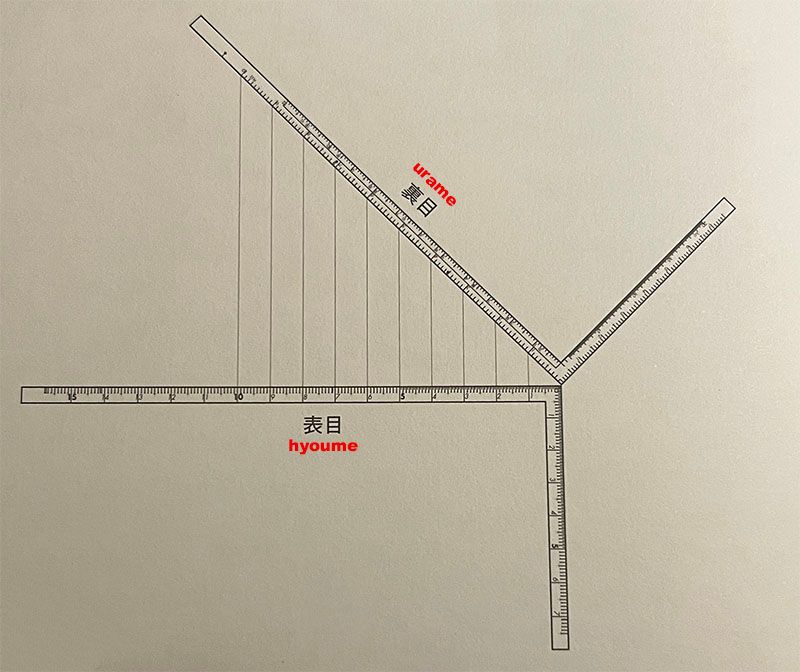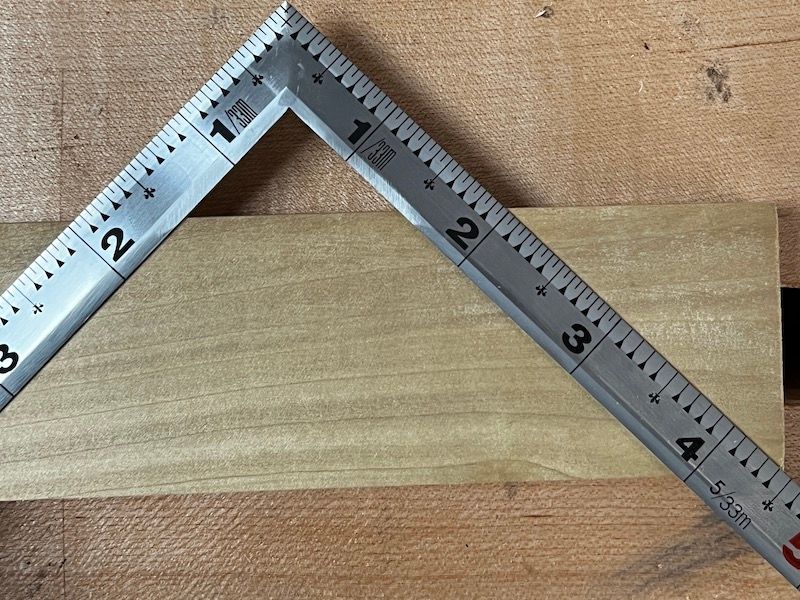Hyoume and urame
About the different scales on the top and bottom of a sashigane. Part 4 in a series.
This is part four (and possibly the most important!) in a series of posts:
- Sashigane 1: Introduction
- Sashigane 2: Traditional Units
- Sashigane 3: Physical design
- Sashigane 4: Hyoume and Urame (this post)
- Sashigane 5: Kou, ko, gen
- Sashigane 6: Simple usage
- Sashigane 7: Right triangle magic
Japanese names/labels
Unfortunately, we will need to learn and memorize several Japanese names for things.
It would be pointless to create a consistent set of English names for the same concepts, because in many cases the English terms would remain just as opaque. Ultimately, they are just names: it doesn’t matter which language you name things in since you have to memorize the names regardless.
When an equivalent English name is meaningful (the words “rise” and “run,” for example) I’ll try to provide both.
Hyoume and Urame
The top side and the bottom side of the sashigane have different scales. The length of equivalently marked divisions on the bottom side are longer than those on top (1.414 times longer to be precise)!

This confuses many people. To the point that manufacturers now also make them available with identical scales on both sides. This is a crying shame because the two bottom secondary scale allows an amazing number of complex layout tasks to be performed with ease. Seriously, this is where the magic happens!
By convention, the “top” (表 ) of the sashigane faces up when you hold the long arm in your left hand, with the short arm on the right and pointing downward.
The “bottom” (裏 ) is the opposite side (flipping either the long or short arm to point in the other direction exposes the bottom side). (Yes, I realize that kanji character looks similar, very similar, to the character for top. Believe me, I know!)
As shown in the diagram below, the top (normally sized) graduations are called hyoume (表目) .
The bottom side graduations, or urame (裏目) , however, are √2 times longer (the top side lengths multiplied by 1.414).
[Terminology isn’t consistent even in Japan. Some carpenters call these bottom-side units kakume (角目 ) instead of urame (or “angle units” instead of “bottom units”). I’ll always use kakume in this series.]
You probably remember the Pythagorean theorem for right triangles from high school:
a2 + b2 = c2
Where c is the hypotenuse.
Well, if a and b are the same length, then this simplifies to
a2 + a2 = c2
or
2 × a2 = c2
Take the square root of both sides, and you end up with:
c = √2 × a
What this means in practice is that one function of a sashigane is to automatically find 90° and 45° angles:
Measuring 45° angles
Say you have a board with straight, parallel edges. If you wanted to cut the end off at 90°, it would be trivial: you’d just hold the long arm of the sashigane against one edge and strike a line along the perpendicular short arm. Then you’d cut along that marked line.
But if you wanted to cut the end at 45° it would be almost as easy:
Using the top side of the sashigane, align it along one edge such that the same number aligns with edge on both arms. You can use whatever number is convenient, just use the same number on the nagate as on the tsumate.
Strike your line (which is guaranteed to be at exactly 45°).
Here’s an example of marking the end of a board at 45° using a 2 寸 measurement for convenience (using the 2 mark on both legs):

Checking for square
This also allows provides another way to check if something is truly square or to make it square.
Let’s say you’re trying to build a square box, with all four sides exactly the same length and perpendicular to each other.
Merely checking for 90° angles in each corner doesn’t suffice: you might have a rectangle rather than a square.
One way would be to measure one side to ensure it’s the desired length, then measure both diagonals to ensure they are both the same length (just comparing for identical lengths, ignoring the actual reading).
Japanese carpenters, however, would be more likely just measure both diagonals using urame units. If both measurements are the same, then they know it’s square, and the measurement itself is the true length of any side (in normal, hyoume measurements). Two measurements instead of three!
Note that this is also useful when gluing up. It’s easy to create a parallelogram instead of a square if you aren’t careful – even if all four sides are the same length. To prevent this, just squeeze the longer diagonal during glue-up until the urame reading is the same as the desired hyoume reading for a side.
The sashigane makes laying out squares and 45° angles trivial!
The next part of this series will discuss laying out other angles using the magic of slopes versus degrees or radians.